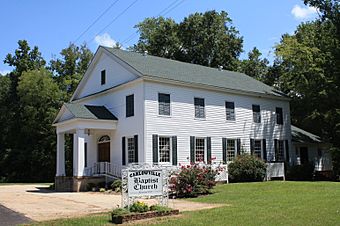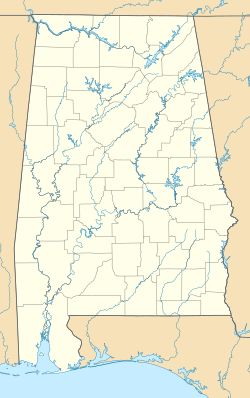Carlowville Historic District facts for kids
Quick facts for kids |
|
|
Carlowville Historic District
|
|

Carlowville Baptist Church (circa 1837)
|
|
| Nearest city | Carlowville, Alabama |
|---|---|
| Area | 780 acres (320 ha) |
| Architect | Multiple |
| Architectural style | Federal, Greek Revival, late 19th And 20th century revival styles |
| NRHP reference No. | 78000487 |
| Added to NRHP | January 18, 1978 |
The Carlowville Historic District is a special area in the community of Carlowville, Alabama. It's like a time capsule, showing off old buildings and homes. This district covers about 780 acres. It's located around Alabama State Route 89 and some local roads. This important place was added to the National Register of Historic Places on January 18, 1978.
What Makes Carlowville Special?
The Carlowville Historic District is known for its beautiful mix of old buildings. It shows how architecture changed over the 1800s and 1900s. All of this is set in a peaceful, rural area.
Most of the older buildings are made of wood. They range from fancy, large houses called mansions to simpler, everyday homes. Some of these homes are still owned by the same families. Their ancestors moved here from the East Coast almost 200 years ago.
Some of the bigger houses were built on brick basements. Over time, some of these brick ground floors were removed. The houses were then lowered. This was likely done because of dampness or the quality of the local bricks.
Important Buildings in the District
When the Carlowville Historic District was first recognized, it had 21 important buildings. These buildings are called "contributing properties." They help tell the story of the district's history. Most of them were built in the Colonial Georgian, Federal, and Greek Revival styles. The Greek Revival style is the most common.
Here are some of the most important buildings:
- Rumpt-Alison House (around 1840): This is a two-story house in the Greek Revival style. It has a grand porch with two levels.
- Alison-Wade House (1849): This two-story house is in the Colonial Georgian style. It features a small, one-story porch.
- St. Paul's Episcopal Church (1838): This church has a Greek Revival-style front porch with four columns. It also has a bell tower and windows added later in the 1800s.
- Carlowville Baptist Church (around 1837): This Federal-style building has a pointed roof at the ends. It features a porch at its main entrance.
- Lee-Wade House (1841): This two-story Greek Revival-style house also has a pointed roof at the ends. It features a very large porch. It originally had a brick ground floor.
- Alison-Youngblood House (1833): This house was updated in the 1920s. It was changed to the Neoclassical style, which looks back to ancient Greek and Roman designs.
- St. Paul's Episcopal Church Rectory (mid-1800s): This one-story Greek Revival-style building was once the home for the church's minister. It also originally had a brick ground story.
- Calhoun Law Office (1840): This small building was a professional office. It was built in the Greek Revival style by Judge James Martin Calhoun. He was a nephew of a famous politician named John C. Calhoun.
See also
 In Spanish: Distrito histórico de Carlowville para niños
In Spanish: Distrito histórico de Carlowville para niños




